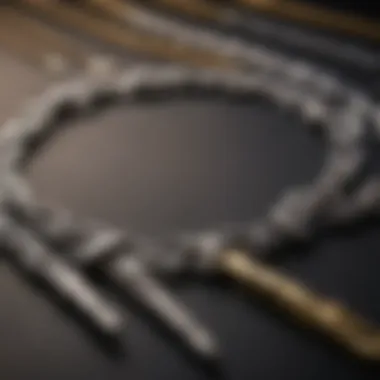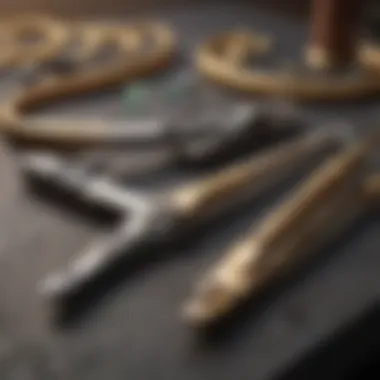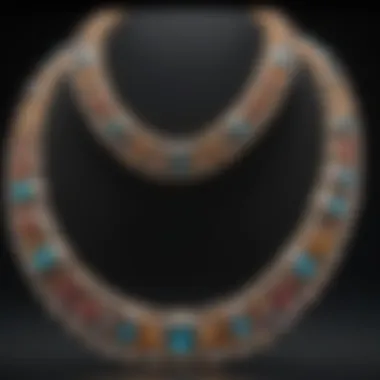Expert Techniques for Repairing a Broken Necklace Chain


Intro
Repairing a broken necklace chain is an essential skill for jewelry owners. This task can sometimes feel daunting, especially if the necklace holds emotional or monetary value. Understanding the repair process is valuable knowledge. It empowers individuals to maintain their jewelry and prolong its life.
In this guide, you will learn about various methods for repairing a necklace chain, including DIY techniques and professional assistance. You will also find details on necessary tools and materials, as well as preventive measures to keep your jewelry in top condition. This comprehensive resource is tailored for anyone interested in effective necklace maintenance, ensuring both aesthetics and longevity.
Overview of Necklace Chains
A necklace chain consists of interlinked segments, formed from a range of materials, including metal, leather, and beads. Necklace chains come in various styles, such as cable, curb, and box chains. Each type has unique characteristics and may require different repair approaches.
Chains can break for various reasons. Common issues include overuse, accidental tugs, or poor quality links. Knowing how to address such problems can save both time and money. Repairing a necklace chain may might appear challenging initially; however, the proper knowledge and techniques can simplify this task considerably.
"Diamonds may be forever, but chains certainly can be repaired."
Next, we will explore the essential tools and materials needed for effective repair, setting a foundation for more advanced techniques.
Essential Tools and Materials
Before initiating the repair process, gather the necessary tools and materials. A well-prepared workspace makes the task easier.
Tools:
- Pliers (flat-nose and round-nose)
- Wire cutters
- Tweezers
- Magnifying glass (optional, for small parts)
- Ruler or measuring tape
Materials:
- Replacement links (if needed)
- Jewelry glue (for specific repairs)
- Jump rings
- Clasp (if the original clasp is damaged)
With these tools and materials in hand, you are ready to tackle the repair. Let's move into detailed step-by-step methods you can use.
Step-by-Step Repair Techniques
1.
Assess the Damage Begin by carefully examining the necklace chain. Identify the point of breakage and any other signs of wear. Understanding the structure of the chain can guide which repair method suits it best.
2.
Use of Jump Rings If the break occurred at a link, adding a jump ring may be the simplest solution. A jump ring connects broken sections, restoring the chain's integrity. Use pliers to open the ring, slide it onto the broken ends, and then close it securely.
3.
Replacing Links For more severe breaks involving missing links, replacement links are necessary. This requires removing the damaged section and inserting a new link. Cut the damaged area with wire cutters, removing any jagged edges. Then, attach the new link using pliers to secure it properly.
4.
Professional Help If the damage is extensive, consulting a professional jeweler may be wise. Jewelers possess specialized knowledge and tools for complicated repairs. While it’s often more expensive, professional repair can save valuable pieces from further harm.
Preventive Measures
Maintaining your necklace chain is as critical as repairing it. Regular checks for wear and tear can prevent future breaks. Here are some key tips to follow:
- Store jewelry in a soft pouch or a dedicated box to avoid scratching.
- Clean chains regularly using mild soap and water.
- Avoid exposing necklaces to harsh chemicals.
End
Understanding how to repair a broken necklace chain is not just practical; it reflects respect for your jewelry. Whether you choose to opt for DIY solutions or seek professional assistance, being informed is key. By applying the techniques outlined in this guide, you can maintain your necklace's beauty and function over time.
Understanding Necklace Chains
Understanding necklace chains is crucial for anyone involved in jewelry maintenance, whether they are casual wearers or dedicated collectors. Necklace chains come in various designs and materials, and knowing these differences helps in assessing repair needs and preventing future damage. An appreciation for the types of chains and common breakage causes also enhances one's ability to make informed choices when purchasing or caring for jewelry.
Types of Necklace Chains
Link Chain
Link chains are among the most recognized styles, comprising interconnected metal links. They are highly versatile and can accommodate a myriad of pendants, making them a popular choice. The key characteristic of link chains is their flexibility and strength. However, their design means they can be vulnerable to breakage if pulled too hard. Assessing a link chain's structure allows for easier repair, as individual links can often be replaced without damaging the overall design.
Beaded Chain
Beaded chains feature a series of beads strung together, offering a decorative aspect. They can be made from various materials such as precious stones or glass. Their primary advantage is aesthetic appeal; however, they can be less durable than metal chains. The unique structure makes repairs more complex, as losing even one bead can result in significant damage to the necklace. Knowing how to handle these chains helps prevent extensive repairs down the line.


Snake Chain
Snake chains consist of smooth, curved metal plates that create a flexible, sleek appearance. This design minimizes tangling, making snake chains a functional choice. The critical characteristic lies in their seamless elegance and adaptability. That said, their delicate construction can make them susceptible to kinks and breaks. Proper handling and storage are vital for maintaining their integrity and minimizing repairs.
Rope Chain
Rope chains are twisted to resemble a rope, offering both strength and visual appeal. Their robust construction makes them suitable for everyday wear. Highlighting a gamble for beauty and durability, rope chains can endure wear better than other styles. Despite their toughness, they may still break under excessive strain. Understanding their composition is essential for anyone wishing to maintain them effectively.
Box Chain
Box chains consist of square links arranged in a simple, elegant pattern. They provide excellent support for heavier pendants due to their sturdy construction. A box chain's unique feature is its strength despite its lightweight appearance. However, like other chains, they can break at the links if stressed improperly. Recognizing their characteristics helps in making strategic choices concerning repairs and maintenance.
Common Causes of Breakage
Excessive Force
Excessive force accounts for a significant number of breakages in necklace chains. Whether through pulling or snagging, applying too much tension can compromise the integrity of a chain. This issue is not only about the strength of the materials used but also about user awareness in handling the jewelry. Understanding the limits of each chain type is beneficial for developing careful handling habits.
Poor Quality Materials
When chains are constructed from inferior materials, they often become prone to breakage. For instance, chains made from low-quality metals can tarnish, weaken, and eventually snap. The type of material used can significantly affect the chain's lifespan. Opting for jewelry made with ethically sourced and durable materials is essential for long-term satisfaction.
Age and Wear
Over time, chains naturally experience wear and tear. Aging can lead to weak spots in the design, which may not be visible until they break. Regular inspections can identify potential issues early. Being proactive about maintenance will prolong the life of any chain regardless of its age.
Improper Storage
Improper storage techniques often lead to tangling and unnecessary stress on necklace chains. Storing necklaces in a tangled state can create weak points. Proper storage solutions, like jewelry boxes or hooks, help maintain the chain's form and integrity. Being mindful of how jewelry is stored is a simple yet effective way to prevent future damage.
Essential Tools and Materials
In repairing a broken necklace chain, having the right tools and materials is crucial. Proper tools help ensure that the repair process is efficient, effective, and safe for the jewelry. Each tool serves a purpose, and understanding their functions can assist in achieving the desired outcome, whether repairing for oneself or as a professional service.
Basic Repair Kits
Jewelry Pliers
Jewelry pliers are a fundamental tool in chain repair. They allow for precise manipulation of small components without damaging delicate parts. The rounded tips are particularly useful for gripping and bending metal links without leaving marks. Their ergonomic design makes them comfortable for extended use.
Key Characteristics
Jewelry pliers often have multiple types, like flat-nosed, round-nosed, and chain-nose pliers. Each type has its unique application, but the versatility of having multiple options makes them a wise choice for this endeavor.
Advantages
Using jewelry pliers simplifies the process of opening and closing links, making it efficient. However, selecting the wrong type can lead to increased effort or damage to your jewelry, so understanding their specific use is essential.
Jump Rings
Jump rings are small metal rings used to connect different components of jewelry. They are essential for linking broken chain segments or attaching clasps securely. The ease of use makes them popular among jewelry repair enthusiasts.
Key Characteristics
Jump rings come in various sizes and materials, including gold, silver, and copper. The good fit and strength of a jump ring impact the overall durability of a repair.
Advantages
They provide a reliable way to restore functionality to a chain. However, one must be careful to choose rings of appropriate gauge to avoid weakening the chain after repair.
Wire Cutters
Wire cutters are vital for any basic repair kit. They help in cutting the chain or jump rings precisely, leading to clean edges that can be easily linked again. Their sharp blades make them an integral tool for any jewelry repair.
Key Characteristics
Quality wire cutters are designed for precision and durability. They can handle various metal thicknesses, but their performance relies heavily on maintaining sharpness.
Advantages
Using wire cutters prevents fraying that may occur with other cutting tools. Nonetheless, improper use can lead to jagged edges, which could complicate further repairs.
Clasps


Clasps are mechanical devices that secure a necklace around the wearer's neck. A broken clasp often renders a chain unusable, making them a critical component in repair. The choice of clasp can significantly affect the overall functionality and aesthetic of the piece.
Key Characteristics
Several types of clasps, like lobster claw and spring ring, exist. Each design offers distinct benefits regarding ease of use and security of closure.
Advantages
Properly fitting clasps can ensure long-term usability. On the downside, selecting the wrong type may lead to frequent repairs, especially if it does not match the chain style well.
Optional Additional Materials
Adhesives and Glues
While not the first choice for many jewelry repairs, adhesives can offer a solution for certain types of breaks, especially in beaded chains. They can fill gaps and bond materials that might otherwise be difficult to connect.
Key Characteristics
The effectiveness of adhesives varies significantly. Some are designed specifically for jewelry, providing the right balance of flexibility and strength.
Advantages
In situations where traditional mechanical repair isn’t viable, adhesives can be a quick solution. Nevertheless, their longevity can be questionable, depending on usage and exposure to elements.
Soldering Tools
Soldering is a method used to fuse metal pieces together. It comes into play for repairs that require more permanence than a jump ring can offer. Having soldering tools on hand can be a game-changer for more serious chain damage.
Key Characteristics
Soldering requires several tools, including a soldering iron, solder, and flux. Understanding how to use them is essential, as improper application can cause further damage.
Advantages
Soldering creates strong bonds, ideally suited for metal chains. On the flip side, it demands skill and practice to master, making it a less accessible option for beginners.
Replacement Links
In cases where individual links have broken, having replacement links is a smart choice. These links can efficiently restore the chain to its original form if sourced correctly.
Key Characteristics
Replacement links must match the original in terms of size and style. Choosing the right ones helps maintain the integrity and design of the chain.
Advantages
They effectively replace damaged segments without compromising strength. However, finding the exact match can be difficult, which may lead to mismatched repairs.
Repairing a broken necklace chain requires a thoughtful approach to selecting tools and materials. Each item in the toolkit plays an essential role in achieving a successful outcome.
DIY Repair Techniques
DIY repair techniques play a crucial role in maintaining the longevity of jewelry, specifically necklace chains. By adopting these methods, one can save on repair costs and gain a deeper understanding of their beloved pieces. Knowing some basic techniques helps build confidence and empowers collectors to handle simple problems independently. Furthermore, these techniques require minimal investment in tools and materials, making them accessible to everyone.
Simple Chain Link Replacements
Chain links may break or become damaged due to various factors such as wear and tear or accidental force. Replacing a chain link is a straightforward task that can restore functionality without requiring professional intervention. To perform a simple link replacement, first, identify the damaged link. Then, use jewelry pliers to open the adjacent links, allowing you to remove the broken section. This action requires care to avoid damaging surrounding links. Once removed, insert a new link and carefully close the opened links using the pliers to ensure a secure fit.
Using Jump Rings for Open Links
Jump rings are particularly useful for making repairs to broken necklace chains, especially when a link has become completely detached. To reattach an open link using jump rings, first gather your tools, including the jump rings and pliers. Open a jump ring by twisting it sideways with the pliers; avoid pulling it apart to retain its shape. Then, thread the jump ring through the open link and the adjacent link. Finally, securely close the jump ring. This method ensures that the chain regains its strength while maintaining flexibility at the breakage point.
Reattaching Clasps
Clasps are essential components of necklace chains, providing secure closures. If a clasp has become detached, reattaching it is a simple process. Start by examining the clasp and the chain's end to identify any holes or openings where the clasp was anchored. Use jewelry pliers to attach the clasp by threading it through the chain's end. Make sure the connection is tight and secure to prevent future breakage. Use a small jump ring if necessary to ensure a stronger hold between the clasp and the chain.
Soldering Techniques for Metal Chains
For metal chains, soldering offers a robust technique to mend broken links. This method provides a permanent solution that can withstand stress better than other techniques. Start by gathering soldering tools, including a soldering iron, solder, and flux. Prepare the broken ends by cleaning and aligning them. Apply flux to the joint, then heat the area with the soldering iron. Introduce solder to the joint until it fills the gap. Allow it to cool, ensuring a solid bond. Remember, soldering may require experience for perfect execution and should ideally be practiced before attempting on valuable jewelry.
Professional Repair Options
Repairing a broken necklace chain can sometimes be straightforward. However, there are situations where professional repair options become necessary. This section elaborates on why seeking help from experts can be beneficial. From assessing the extent of damage to ensuring the longevity of a treasured piece, the insight provided can save time and preserve the jewelry's value.


When to Seek Professional Help
Recognizing when to consult a professional is crucial. Not every repair is suited for a DIY approach. Here are instances where professional assistance should be considered:
- Severe Breakage: If the chain is extensively damaged, trying to fix it yourself can lead to further issues.
- Complex Designs: Intricate or delicate designs often require specialized skills to prevent more damage.
- High-Value Pieces: For expensive necklaces, maintaining value through expert repair is essential.
For instance, if a vintage piece from Tiffany & Co. breaks, you may want a professional to handle it.
Choosing a Qualified Jeweler
Selecting the right jeweler is vital for a successful repair. Consider these factors when making your decision:
- Experience and Expertise: Look for jewelers with significant experience in jewelry repair, specifically with necklace chains. Inquire about their background and previous work.
- References and Reviews: Check reviews online. Websites like Facebook and Reddit can provide insights into customer experiences.
- Repair Warranty: Reputable jewelers often offer guarantees on repairs, giving you peace of mind.
It can be beneficial to consult local jewelry stores or specialized repair services for personalized assessments.
Understanding Repair Costs
Repair costs can vary widely based on several elements, including:
- Type of Damage: Simple link replacements cost less than intricate soldering jobs.
- Material of Necklace: Precious metals like gold or platinum may command higher repair prices compared to silver.
- Labor Fees: The jeweler’s expertise and local market conditions can affect labor costs significantly.
Typically, repairs can range from as low as $10 for minor repairs to several hundred dollars for more complex tasks. Always ask for a detailed estimate.
It is wise to remember that investing in a professional repair can often be less than the cost of replacing an entire piece.
Preventive Measures to Avoid Future Breakage
Preventive measures are essential for maintaining the integrity of your necklace chains. Taking proactive steps can greatly reduce the likelihood of breakage, thereby safeguarding your investment in jewelry. This section highlights effective strategies that contribute to the durability of your necklaces.
Proper Storage Techniques
Proper storage is one of the easiest ways to prevent damage to necklace chains. It is critical to store them in a safe environment that minimizes exposure to potential hazards. Here are some points to consider:
- Use Individual Pouches or Boxes: Keeping necklaces in separate compartments prevents them from tangling or scratching each other.
- Avoid Humid Areas: Humidity can weaken materials, especially if they contain organic components like pearls. Store your jewelry in a dry place.
- Consider Anti-Tarnish Products: For those with silver or other metals that tarnish, using anti-tarnish pouches or cloths can be beneficial.
These simple changes in how you store your necklaces can have a lasting impact on their condition.
Regular Maintenance Practices
Regular maintenance is key to keeping your necklace chains in good shape. This includes cleaning, inspections, and timely repairs as needed. Consider the following practices:
- Routine Cleaning: Regular cleaning removes dirt and oils that accumulate over time. Use a gentle soap solution and a soft cloth for this task.
- Inspection for Damage: Periodically check your chains for signs of wear. Look for areas where links may be thinning or clasps are loose.
- Prompt Repairs: Address any damage immediately. Don't wait for a small issue to escalate into more severe damage.
Implementing these maintenance habits can extend the life of your jewelry significantly.
Choosing the Right Jewelry for Activities
Selecting suitable jewelry for various activities plays a role in preventing breakage. Some occasions demand different considerations regarding jewelry choice:
- Avoid Heavy Jewelry During Physical Activities: When engaging in sports or movement, limit the use of more delicate necklaces.
- Consider the Environment: Jewelry should be appropriate for the setting. For instance, avoid wearing valuable pieces in crowded or risky environments.
- Be Mindful of Chemical Exposure: Stay away from harsh chemicals like cleaning products and lotions when wearing jewelry. These can degrade certain materials.
By making informed choices about when and how to wear jewelry, you can reduce stress on chains and prevent unexpected breakage.
"Taking proactive steps in the care of your jewelry can save time and money in the long run."
Implementing these preventive measures contributes not only to the beauty of your necklaces but also ensures they remain a cherished part of your collection for years to come.
The End
In summary, understanding how to repair a broken necklace chain is a vital skill for any jewelry enthusiast. It allows individuals to extend the life of their pieces and maintain their value. The techniques provided throughout this guide, ranging from simple repairs to more complex solutions, empower you to tackle common issues with confidence.
Summarizing Key Repair Techniques
When it comes to specific repair methods, knowledge is essential.
- Chain Link Replacements: This technique involves identifying and changing out damaged links. Keeping spare links can help facilitate this repair.
- Using Jump Rings: This approach is useful for reconnecting broken chains without needing extensive tools. Simply open the jump ring, thread it through the chain, and close it securely.
- Reattaching Clasps: A simple process that often requires only pliers. Ensure clasps are secure, as they are crucial to the function of the necklace.
- Soldering Techniques: For metal chains, soldering can permanently fix breaks. It requires some skill to execute properly, so practice or guidance may be needed.
These techniques serve different types and styles of necklace chains. Every enthusiast, whether a collector or designer, can benefit from mastering these skills. Repairs can help retain sentimental value and aesthetic appeal, ensuring your favorite pieces remain part of your collection for years to come.
The Importance of Jewelry Care
Jewelry care is not just about fixes; it also encompasses preventive actions. Proper maintenance is crucial for preserving the integrity of your necklaces. This can include:
- Regular Cleaning: Keep chains free of dirt and tarnish using suitable cleaning methods for the materials.
- Organized Storage: Use designated places for storing your jewelry to prevent tangles and scratches.
- Mindful Wearing: Be cautious with necklace choice during physical activities to reduce risks of breakage.
Remember, the value of your jewelry often lies in its condition. Investing effort into care and timely repairs can significantly enhance its lifespan.
By understanding the importance of regular maintenance, you can avoid many common issues with necklace chains. Knowledge in jewelry care not only fosters an appreciation for craftsmanship but also contributes to the longevity of your cherished pieces.







